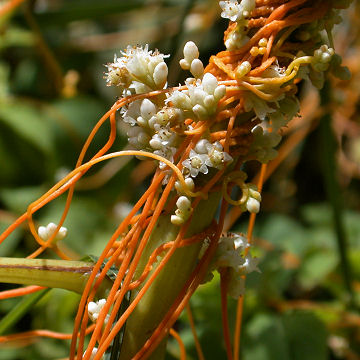

Cuscuta gronovii - (image 1 of 5)
Taxonomy
Family: Convolvulaceae
Habitat
Low, wet areas, often near streams.
Associates
Frequently parasitic on Eupatorium maculatum and Impatiens capensis.
Distribution
Common from Nova Scotia west to Manitoba, south to FL and AZ.
Morphology
Achlorophyllous, parasitic annual. Stems yellow to orange, glabrous, infecting host with haustoria. Leaves absent or scale-like. Flowers sessile in dense clusters; perianth mostly 5-merous; corolla lobes obtuse, sepals united above their bases; calyx not subtended by bracts. Capsules longer than wide; the corolla tube partly sheathing the capsule.
Notes
Flowers July to late September
Wetland Indicator: Obligate
Dodders loose their roots very early in life and become completely dependent on the host plant. Considered a noxious weed in many states (presumably because it is parasitic).
References
Gleason, Henry A.
and A. Cronquist. 1991. Manual of Vascular Plants of Northeastern United States
and Adjacent Canada. Second Ed.
The New York Botanical Garden. Bronx, NY
Swink, F. and G.
Wilhelm. 1994. Plants of the Chicago Region.
Indiana Academy of Science. The Morton Arboretum. Lisle, Illinois.
USDA, NRCS. 2002. The PLANTS Database, Version 3.5 (http://plants.usda.gov).
National Plant Data Center, Baton Rouge, LA 70874-4490 USA.
|
Michael Hough © 2009 |